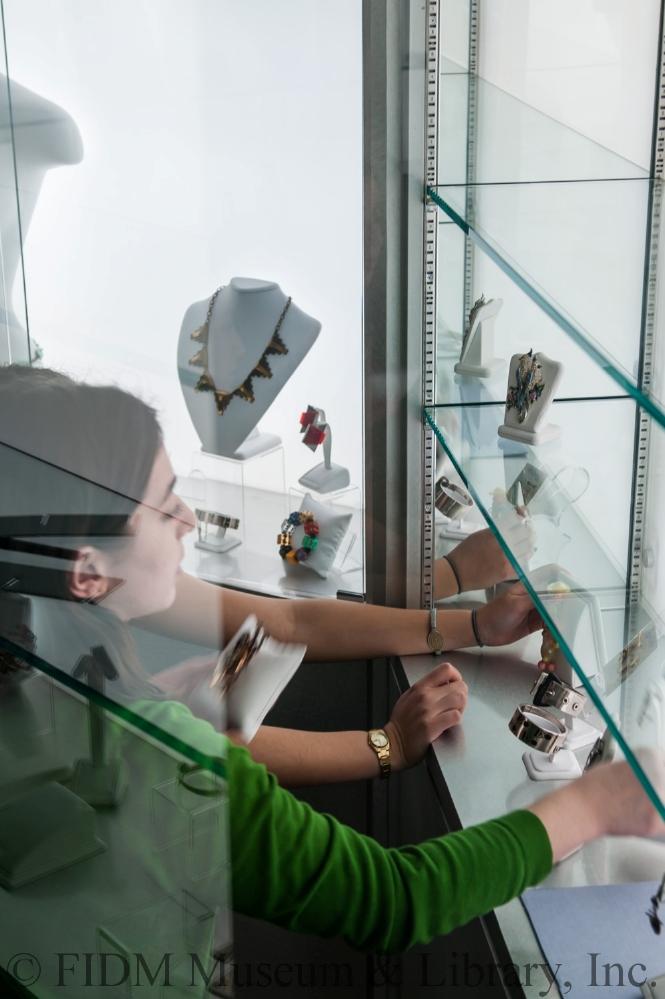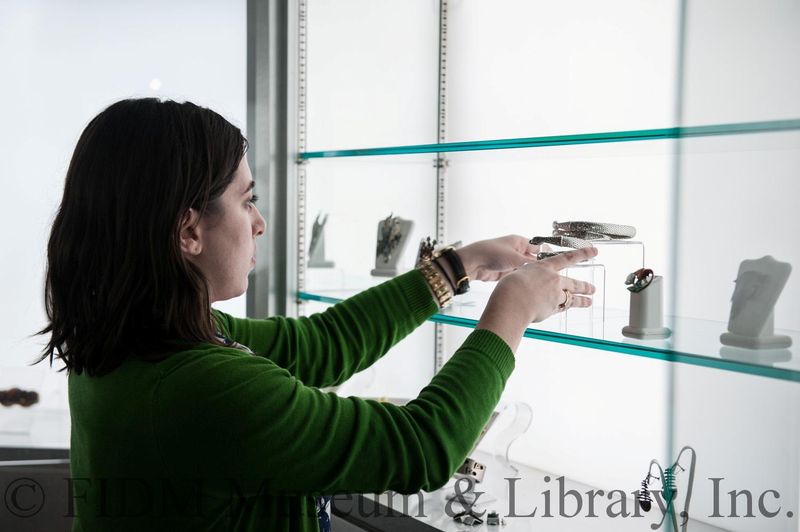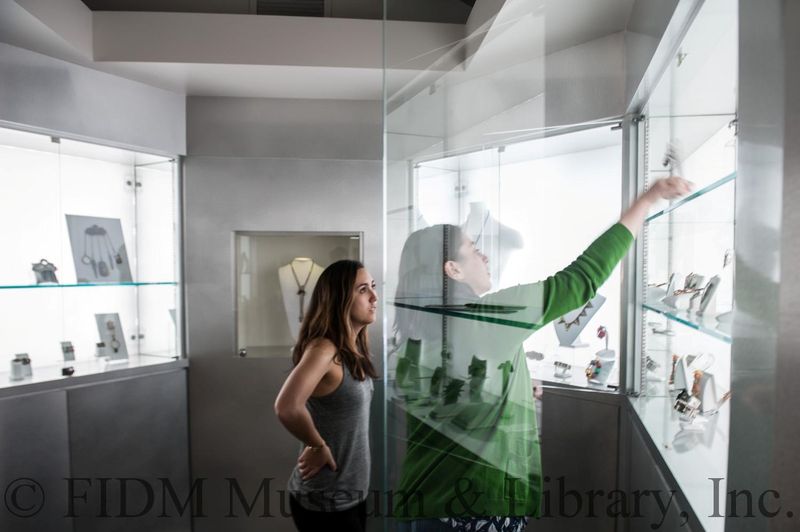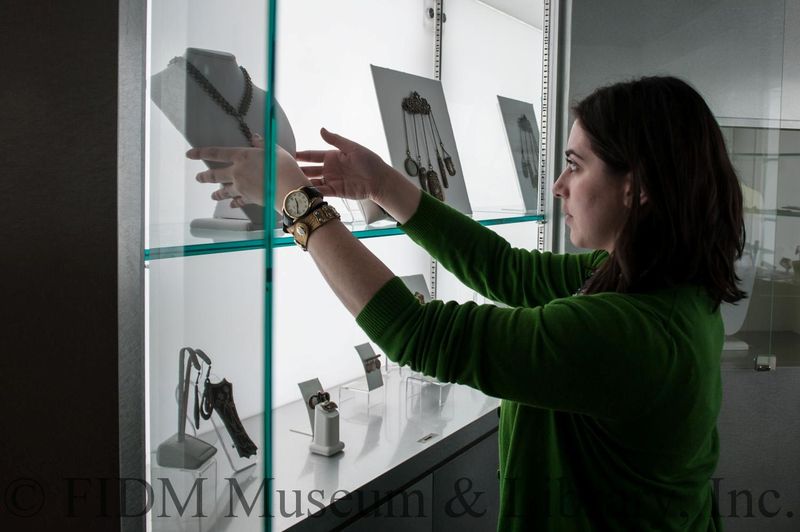Today's post offers a look at the many steps involved in curating Artfully Adorned: Jewelry from the Christie Romero Collection. Now on view in the Annette Green Fragrance Archive, this exhibition explores two centuries of jewelry history. Below, former Interim Assistant Registrar Ilana Winter describes how Artfully Adorned came together.
**********
Putting together an exhibition is like completing a crossword puzzle. Each object is a clue, thematically related to every other object. Once the objects are placed, much like the answers in crossword puzzles, strong connections appear. These connections complete the story of an exhibition. This was definitely the case during an exhibition I recently finished installing.
As Interim Assistant Registrar, I was asked to curate the latest exhibition in the Annette Green Fragrance Archive. In a departure from previous perfume installations, I worked with a recent donation of costume jewelry. The exhibition is titled Artfully Adorned: Jewelry from the Christie Romero Collection. Be sure to see it for yourself. Come by the FIDM Museum where it is currently on view on the 2nd floor. Check-in is required at the security station inside the ground floor rotunda. All visitors must have a current photo ID to access the Annette Green Fragrance Archive. Hours are Mon.-Sat., 10am-5pm. Read on to discover the behind-the-scenes action that went into putting together this year-long jewelry exhibition.
Artfully Adorned began with the decision to create an exhibition based on the Christie Romero costume jewelry collection. This collection spans the 1820s through the 2000s and highlights pieces from all over the world, including New Zealand, England, Egypt, Mexico, the Netherlands, and Scotland. It also includes a variety of jewelry, including necklaces, earrings, rings, bracelets, bola ties, belts, brooches, chatelaines, and dress clips.
The research process lasted several months. In the case of Artfully Adorned, I chose to look at the jewelry like a physical timeline to answer the following questions: What does each object represent in its historical context? How does the design reflect popular aesthetics or art movements? Does it symbolize a greater social significance beyond adornment? The answers to these questions were discovered through two avenues: research and analysis of the objects.
Christie Romero was a gemologist, collector, historian, curator, consultant, and appraiser. Her bestselling book, Warman’s Jewelry (a reference guide to 18th-, 19th-, and 20th-century jewelry) provides great insight into understanding her collection. Her published research explained the significance behind various pieces she had collected. Romero organized her collection chronologically, creating a timeline that showcased the history of jewelry design and its importance. I relied on Romero’s research in designing Artfully Adorned, which exhibits jewelry as a relatable way to connect the present to the past.
In the midst of research, it sometimes felt like the process accelerated from 0 to 60mph in the blink of an eye. I found I had more information than I knew what to do with. I believe the hardest part of curating an exhibition is the editing process. Text panels are written to help guide the viewer through the exhibition—an explanation of the exhibition’s themes and how the objects relate to each other. All the information written for these panels in the gallery space must clearly reflect the most important facts about the objects. Artfully Adorned is on display in the Annette Green Perfume Gallery, which is a fairly small gallery space. In order to keep word counts down to a minimum (so visitors aren’t overwhelmed by the panels), many quotes and entertaining facts had to be left out. Below are some examples of the fun research I came across, that didn’t make it into the exhibition.
- In an article from the May 31, 1947 Saturday Evening Post, the following was used to describe a woman's longing for sparkling baubles during the Great Depression: “Experience in the ‘30’s showed that the industry is peculiarly adapted even to weathering a depression. When a woman can’t afford a new dress, she buys new costume jewelry to brighten up her old ones. When she goes out to seek a job, she finds, in a bit of glitter, a powerful stimulant for her morale.”[1]
- “It does not matter if they are real, as long as they look like junk!” -Coco Chanel, 1924
- Marilyn exclaims, “Diamonds! I don't mean rhinestones! But diamonds are a girl's best friend,” during her big number in Gentlemen Prefer Blondes. However, “Marilyn Monroe’s ‘diamonds are a girl’s best friend’ jewels were really rhinestones, as were Audrey Hepburn’s Breakfast at Tiffany’s baubles.”[2]
Mounting and placing the jewelry is my favorite part of the process. It's both satisfying and exciting to figure out the best way to express the story through the material objects. Every curator has his/her own method to best go about installation. For Artfully Adorned, I made a map of the gallery and placed photos of each object where I thought they would best be utilized. This helped with the initial organization of the collection, and proved useful during installation. Once the objects were in their respective cases, a fantastic team of preparators helped mount and install each piece. Below are images of former intern Mari Ogino and I figuring out the best placement for visual appeal and showcasing the important elements of each piece.
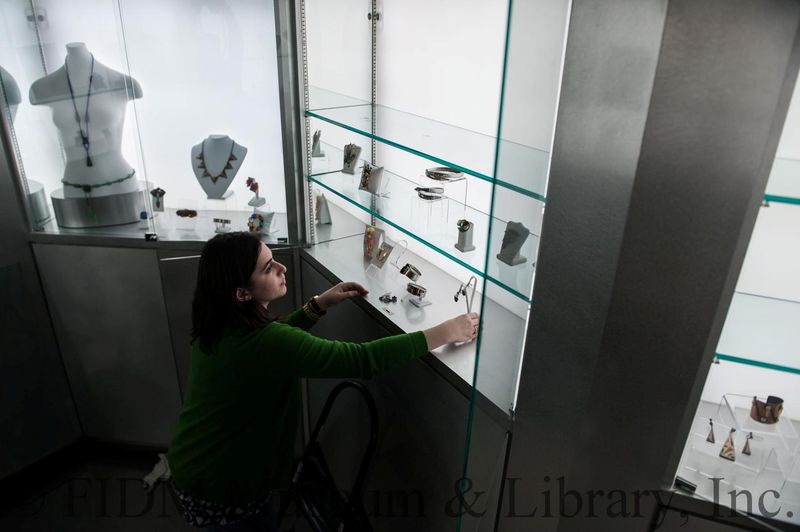
[1] McCormick, Elsie. "Merchants of Glitter," The Saturday Evening Post. Indianapolis, IN: Curtis Publishing, May 31, 1947. 34-35, 114-115.
[2] Romero, Christie. Warman's Jewelry: A Fully Illustrated Identification and Price Guide to 18th, 19th & 20th Century Fine and Costume Jewelry. Iola, WI: Krause Publications, 2002. 200. Print.

